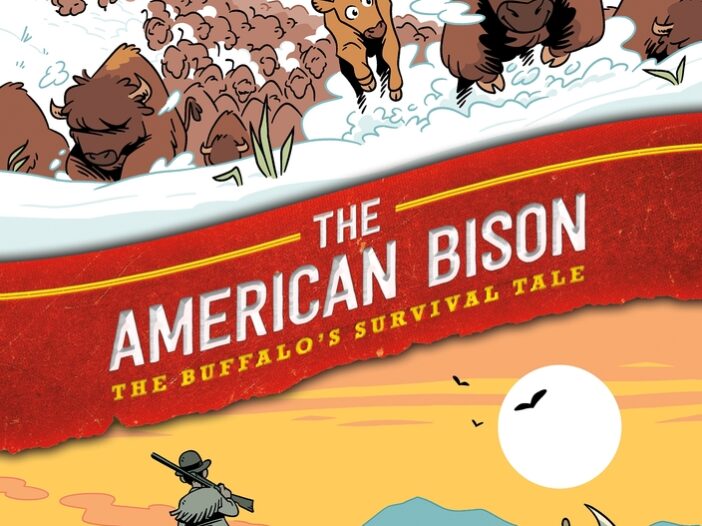
The American Bison | Review
 The American Bison: The Buffalo’s Survival Tale
The American Bison: The Buffalo’s Survival Tale
Writer/artist: Andy Hirsch
First Second; $19.99
The story of bison in North America, in which herds of some 30 million of the huge creatures shrank to the point that they were on the very brink of extinction in the 1880s, is unquestionably a tragedy. But, as cartoonist Andy Hirsch notes at the end of his The American Bison: The Buffalo’s Survival Tale, it’s not just a tragedy.
“But let’s not forget those who bent history away from the worst,” he writes in his author’s note. “There are more bison on the prairie today than a decade ago, than a decade before that, than a decade before that.”
ADVERTISEMENT
ADVERTISEMENT
In that respect, the story of the bison is also an inspiring story, or, at least, elements of it are. It’s not simply the story of how an animal that once seemed astronomically ubiquitous almost vanished, it’s the story of how they didn’t vanish, how enough people cared enough to successfully spare the bison from extinction. And now, slowly but steadily, acre after acre of prairie is being restored, and the animals that once lived there starting coming back, including the bison.
The American Bison is part of publisher First Second’s “History Comics” series, and Hirsch has had plenty of experience creating non-fiction works for them, having previously produced several installments of their “Science Comics” series, including Dogs, Cats and Trees.
In American Bison, he tells the whole story of the bison, beginning in prehistoric times, with a few panels featuring their even more gigantic ancestor, Bison latifrons. From there he traces the way native people and bison evolved together on the plains (and the grasses evolved with them, as Rosalyn LaPier explains in her introduction), reaching a sort of perfect balance in which tens of millions of bison range throughout most of the continent.
Hirsch then traces the many, many forces which lead to the bison’s downfall. It wasn’t just the coming of the railroad and the peculiar, brutal “hobby” of riders firing from train windows into the herds, something most of us probably heard about in school.
It was also the introduction of horses to the continent, the leather market, competition from cattle and, perhaps most sinister of all, the belief that by ridding the plains of the buffalo the plains could also be rid of the Native Americans, thus freeing up more land.
ADVERTISEMENT
ADVERTISEMENT
Eventually things got so bad that in 1886 the Smithsonian’s chief taxidermist William T. Hornaday had concluded it was too late to save the buffalo, which had at that point numbered in the mere hundreds. All he could hope to do at that point, he thought, was to preserve their memory through his art, but even his search for specimens to stuff was frustrated by the extreme rarity of bison.
The story of Hornaday’s search for bison is one of several great stories that Hirsch dramatizes within his overall story. While there are some similarly sad, even tragic anecdotes, there are also some funny ones, including a dramatic bust of a poacher that is re-staged for the media and a man’s attempt to smooth over his marriage to a second wife by bringing his first wife a gift of several bison calves.
It’s a rather rich narrative, as should perhaps be expected of a book that tells a story that is at once a tragedy and also not a tragedy.
Given all the distressing environmental news of the day, with seemingly a million tragedies of various sorts all occurring at once, and countless species imperiled—including, thanks to the climate crisis, human beings themselves—the story of the bison’s survival and gradual recovery isn’t just a good read, it is, perhaps, a necessary one.
“I hope you’ll bend history toward the better,” Hirsch concludes his author’s note. People did it in the past with the bison. Hopefully they’ll do it for the rest of the world in the future, too.
Filed under: Reviews
About J. Caleb Mozzocco
J. Caleb Mozzocco is a way-too-busy freelance writer who has written about comics for online and print venues for a rather long time now. He currently contributes to Comic Book Resources' Robot 6 blog and ComicsAlliance, and maintains his own daily-ish blog at EveryDayIsLikeWednesday.blogspot.com. He lives in northeast Ohio, where he works as a circulation clerk at a public library by day.
ADVERTISEMENT
ADVERTISEMENT
SLJ Blog Network
2024 Books from Coretta Scott King Winners
The Ultimate Love Letter to the King of Fruits: We’re Talking Mango Memories with Sita Singh
Parsing Religion in Public Schools
The Tortured Poets Department Poetry Party Part 2: DIY Frames for Your Instant Photos
ADVERTISEMENT







